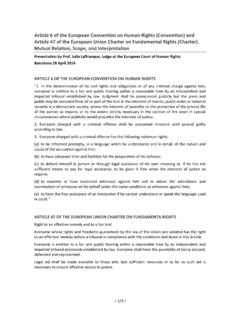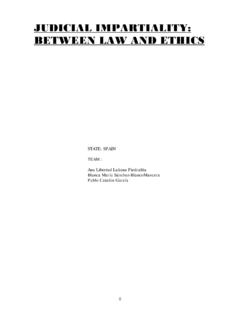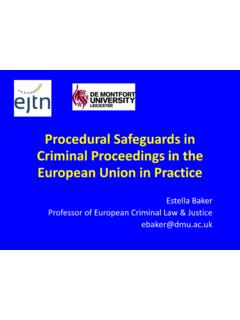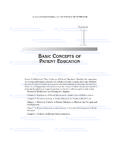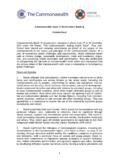Transcription of Legal Reasoning of the Court of Justice in the Context of ...
1 EUROPEAN & INTERNATIONAL LAW Legal Reasoning of the Court of Justice in the Context of the Principle of equality Between Judicial Activism and Self-restraint By Oreste Pollicino* Those with a taste for fairy tales seem to have thought that in some Aladdin s cave there is hidden the Community law in its splendour and that on a judge s appointment there de-scends on him knowledge of the magic words Open Sesame. Bad decisions are given when the judge has muddled the password and the wrong door opens. But we do not believe in fairy tales any more. 1 A. Introduction The law-making function of judges in general, and more specifically of the judges of the Court of Justice , was and continues not only to provoke debates and confron-tations between different doctrinal opinions, but also to act as a battleground for opposing ideologies regarding the functions, powers and limits of the judiciary in our society.
2 The issues involved are by nature trans-sectorial, (with aspects of a Legal , social, economical and political nature), and thus cannot be restricted to a single field of inquiry. The difficulty of this subject would have made a general approach presumptuous. I thus preferred to restrict my study to an analysis of some of the decisions made by the Court of Justice regarding the principle of sex equality . This is a field of inquiry which is particularly suitable for identifying the decisional techniques of the Court , as well as for understanding the concepts of judicial activism and self-restraint and their respective limits. Such an analysis re-quires that we place our conclusions in the Context of a general framework, and establish parameters to help us recognize a creative decision and evaluate its out-come. The first part will deal with the following issues: underlining what I consider the real meaning and extent of a judge s power, with particular emphasis on the spe- * Master in European law, Bologna University; LLM in European law ,College of Europe, Bruges; PhD in Costitutional law, Milan University; Lecturer in Public law, Bocconi University, Milan.
3 1 Lord Reid, The Judge as Law Maker, 12 JOURN .SOC. PUB TEACH LAW 22 (1972). 284 [Vol. 05 No. 03 GERMAN LAW JOURNAL cific role of the European Court of Justice , and identifying and evaluating law-making judicial operations. In the second part, in the light of the framework and the criteria outlined in the first part, I will focus my analysis on three paradigmatic cases in the Context of the prin-ciple of equality in order to apply in practice the theoretical conclusions reached in the first chapter. The third and concluding part will tackle the problem of the present and future constitutional features of the European Judicature, examining if and to what extent the Court of Justice acts as a Constitutional Adjudicator. B. Examining the Law-making Function of the Courts in General and of the Euro-pean Court of Justice in Particular Ever since the creation of the European Community, the Court of Justice has not simply been a group of judges with expertise in European law, but has represented one of the real driving forces of European integration.]
4 In other words, if today there exists something called law, with its own particular features, characteristics, and issues, all this is due to the Court s work. As, in a well known piece, Stein wrote of it, tucked away in the fairyland Duchy of Luxemburg and blessed, until recently, with the benign neglect by the powers that be and the mass media, the Court of Justice of the European Communities has fashioned a constitutional framework for a federal-type structure in Europe. 2 The masterpiece of the Euro-pean Court has been the constitutionalisation of the Treaties, which, by nature, are sources of international law. It would have been inconceivable to bring about such a radical transformation without applying a degree of judicial creativity. Of course, every conquest has its price, and the Court has had to pay the price of no longer being subject to benign neglect but becoming, on the contrary, the target of harsh accusations and the 2 E.
5 Stein, Lawyers, Judges and the Making of a Transnational Constitution, A. J. INTN L L. 1 (1981). 2 H. RASMUSSEN, ON LAW AND POLICY IN THE EUROPEAN Court OF Justice (Martinus Nijolf ed., Copen-hagen 1986); H. Rasmussen, Between Self restraint and Activism: A Judicial Policy for the European Court , 13 EUR. L. REV. 28 (1988); P. Neill, The European Court of Justice : a Case Study in Judicial Activism, 218, Inter-governmental Conference, Minutes of Evidence, House of Lords 1996. 2004] 285 Legal Reasoning of the Court of Justice beneficiary of valiant defences for the way in which it has interpreted its judicial I do not intend to deal directly with the legitimacy of the Court s role. Rather, I would like to examine the relations, first in a general Context and then in a Com-munity framework, between the scope of judicial functions and the necessity of judicial creativity.
6 By adopting this approach it will be possible to better under-stand the peculiarity of the European judicature and its importance in the process of European integration. After having examined the various options highlighting the nature and essential features of judicial activism, so widely studied and discussed by Legal scholars, I shall apply the a contrario method. In following this approach I will try to under-line what law making is not, in order to eliminate possible misunderstandings and misleading definitions, and thus allow the authentic nature of law making to emerge. In particular, I will contest the validity of three assertions that are frequently brought up in the debate on this issue. These assertions, which, if taken seriously, prevent us from realising the essence of judicial law-making power, are: 1) Such power is not implicit in the judicial function, but is a degeneration of it.
7 2) Judicial law-making power is tantamount to legislation 3) Judicial law-making power is an exclusive pro-integration decisions prerogative and does not concern situations where the Court of Justice adopts an approach of self- restraint. I shall review each of these definitions in turn. I. Judicial Law-making: Degeneration or Expression of Judicial Functions In doctrinal debate we often come across the conviction that a clear distinction ex-ists between Legal interpretation and judicial activism. According to this distinction, the former is considered a legitimate expression of judicial function and the latter its degeneration, involving a judge s arbitrary intrusion into the political arena by 3 Weiler, The Court of Justice on Trial, 24 COMMON MARKET L. REV. 555 (1981); M. Cappelletti, Is the European Court of Justice Running Wild?, 12 EUR.
8 L. REV. 3 (1987); M. Cappelletti, The Law-Making Power of the Judges and its Limits, M. U. L. REV. 15 (1981); , In Praise of Judicial Activism, but What Does It Mean? And Has the European Court of Justice ever Practiced It?, in SCRITTI IN ONORE DI , 505 (Curti Gialdino ed., Milano 1998); T. Tridimas, The European Court of Justice and Judicial Activism, 21 EUR. L. (1996); Mancini, Attivismo e Autocontollo nella Giurisprudenza della Corte di Giustizia, RDE 229 (1990); Lord Slynn of Hadley, What is a European Community Judge?, 52 234 (1993). 286 [Vol. 05 No. 03 GERMAN LAW JOURNAL giving priority to values other than Legal ones, such as, in the case of the ECJ, sup-porting the process of European integration. It must be emphasised that the afore-mentioned conviction is misplaced, being based on an old and reductive concept of judicial function, whereby the judge was seen as an inanimate, robot-like spokes-man of the law.]
9 This concept confirms the idea that by purely deductive logic the judge could ascertain the law without personal responsibility or creative means. By contrast, it must be underlined that judicial function involves per se not only the interpretation of law but also its creation. If one accepts this fundamental observa-tion, there is no clear distinction between Legal analysis or interpretation on the one hand and judicial law-making on the other. In fact both of them, far from belonging to different spheres, the former Legal and the latter political, fall within the bounda-ries of legitimate judicial function. The conclusion that law-making is per se part of judicial functions allows us to re-consider the current debate and try, instead of explaining law-making decisions as a shift from law and towards politics, to find an explanation inside the Legal system4 itself. It might be interesting, firstly, to briefly examine the reasons for the birth and ex-pansion of the creative role of judicial interpretation in general, and, secondly, the specificity of European judicial activism.
10 1. Reasons behind the creative role of judicial interpretation. Awareness of the potential creativity within the judicial function has been height-ened by two main factors: a different approach to the method of interpretation and the radical transformation of the role of law and government in modern welfare societies. The new interpretative approach was called the revolt against formalism, 5 and it is characterised by two innovative elements, which both display elements of judi-cial creativity: the method of systematic interpretation and the relevance of the 4 This concept has been elaborated by Authors influenced by F. Geny. According to this view, deciding a case cannot merely consist of subsuming certain facts under a pre-existing rule of law; the decision itself will add to the interpretation of the rule to be applied, and may thus help to define its meaning.




